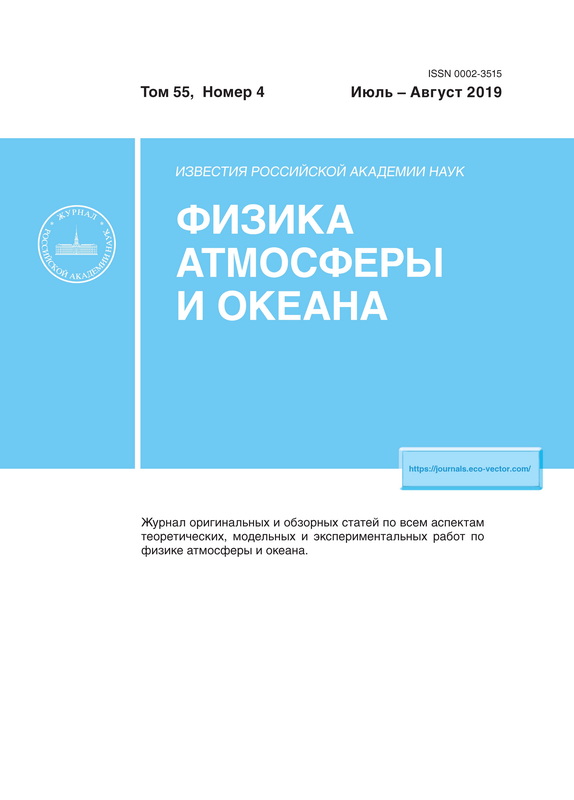100 000-летняя ритмичность в ледниковых циклах и колебаниях уровня мирового океана
- Авторы: Безверхний В.А.1
-
Учреждения:
- Институт физики атмосферы им. А.М. Обухова РАН
- Выпуск: Том 55, № 4 (2019)
- Страницы: 37-44
- Раздел: Статьи
- URL: https://journals.eco-vector.com/0002-3515/article/view/16119
- DOI: https://doi.org/10.31857/S0002-351555437-44
- ID: 16119
Цитировать
Полный текст
Аннотация
100-тысячелетняя ритмичность в изменениях климата в позднем плейстоцене (в последние 800 тыс. лет) может быть связана с соответствующими колебаниями не только в инсоляции, но и в подводной вулканической активности под воздействием сил гравитации в солнечной системе. Это заключение основано на вейвлетном анализе долговременных данных о колебаниях эксцентриситета орбиты Земли, вариациях различных палеоклиматических характеристик, их известных спектральных оценках и данных о подводной вулканической активности.
Об авторах
В. А. Безверхний
Институт физики атмосферы им. А.М. Обухова РАН
Автор, ответственный за переписку.
Email: vabezv@mail.ru
Россия, 119017, Москва, Ж-17, Пыжевский пер., 3
Список литературы
- Berger W.H. Milankovitch theory — hits and misses. Scripps Institution of Oceanography Technical Report // Scripps Inst. Oceanogr. UC. San Diego. Ca. 2012.
- Maslin M. Forty years of linking orbits to ice ages // Nature. 2016. V.540. P. 208–210.
- Мохов И.И., Безверхний В.А., Карпенко А.А. Диагностика взаимных изменений содержания парниковых газов в атмосфере и температурного режима по палеореконструкциям для антарктической станции Восток // Изв. РAH. Физикa aтмocфepы и oкeaнa. 2005. Т. 41. № 5. C. 579–592.
- Мохов И.И., Безверхний В.А., Карпенко А.А. Взаимные изменения температурного режима и содержания парниковых газов в атмосфере по палеореконструкциям для последних 800 тысяч лет // Экстремальные природные явления и катастрофы. Т. 1. Оценка и пути снижения негативных последствий экстремальных природных явлений. Отв. ред. А.О. Глико. М.: ИФЗ РАН. 2010. С. 312–319.
- Berger A., Loutre M.F. Insolation values for the climate of the last 10 million years // Quat. Sci. Rev. 1991. V. 10. P. 297–317.
- Ruddiman W.F. Orbital changes and climate // Quat. Sci. Rev. 2006. V. 25. P. 3092–3112.
- Shackleton N.J. The 100,000-Year Ice-Age Cycle Identified and Found to Lag Temperature, Carbon Dioxide, and Orbital Eccentricity // Science 2000. V. 289 P. 1897–1902. doi: 10.1126/science.289.5486.1897
- Ganopolski A., Calov R. The role of orbital forcing, carbon dioxide and regolith in 100 kyr glacial cycles // Clim. Past. 2011. V. 7. P. 1415–1425.
- Berger A., Melice J.L., Loutre M.F. On the origin of the 100-kyr cycles in the astronomical forcing // Paleoceanography. 2005. V. 20. PA4019. P. 1–17. doi: 10.1029/2005PA001173
- Maslin M.A., Brierley C.M. The role of orbital forcing in the Early Middle Pleistocene Transition // Quat. Intern. 2015. V. 389. P. 47–55.
- Tziperman E., Raymo M.E., Huybers P.J., Wunsch C. Consequences of pacing the Pleistocene 100 kyr ice ages by nonlinear phase locking to Milankovitch forcing // Paleoceanography. 2006. V. 21. PA4206. P. 111.
- Siddall M., Honisch B., Waelbroeck C. Huybers P. Changes in deep Pacific temperature during the mid-Pleistocene transition and Quaternary // Quat. Sci. Rev. 2010. V. 29. P. 170–181.
- Lisiecki L.E. Links between eccentricity forcing and the 100,000-year glacial cycle // Nature Geosci. 2010. V. 3. P. 349–352.
- Lisiecki L.E., Raymo M.E. A Pliocene-Pleistocene stack of 57 globally distributed benthic δ18O records // Paleoceanography. 2005. V. 20. PA1003. P. 1–17.
- De Boer B., Lourens L.J., van de Wal R.S.W. Persistent 400,000-year variability of Antarctic ice volume and the carbon-cycle is revealed throughout the Plio-Pleistocene // Nat. Commun. 2014. V. 5. P. 2999.
- Morlet J., Arensz G., Fourgeau E., Giard D. Wave propagation and sampling theory-Part II: Sampling theory and complex waves // Geophysics. 1982. V. 41. № 2. P. 222–236.
- Постников Е.Б. Вейвлет-преобразование с вейвлетом Морле: методы расчета, основанные на решении диффузионных дифференциальных уравнений // Комп. исслед. модел. 2009. Т. 1. № 1. С. 5–12.
- Cappellini V., Constantinides A.G.D., Emiliani P. Digital filters and their applications // London: Academic Press. 1978. P. 393.
- Безверхний В.А. Проявление характерных периодов колебаний орбитальных параметров Земли в палеоклиматических данных // Докл. РАН. 2013. Т. 451. № 3. С. 327–331.
- Huybers P., Langmuir Ch.H. Delayed CO2 emissions from mid-ocean ridge volcanism as a possible cause of late-Pleistocene glacial cycles // Earth Planet. Sci. Let. 2017. V. 457. P. 238–249.
- Ganopolski A., Brovkin V. Simulation of climate, ice sheets and CO2 evolution during the last four glacial cycles with an Earth system model of intermediate complexity // Clim. Past. 2017. V. 13. P. 1695–1716.
- Wang Z.J., Lin X. Astronomy and Climate-Earth System: Can Magma Motion under Sun-Moon Gravitation Contribute to Paleoclimatic Variations and Earth’s Heat? // Advan. Astron. 2015. V. 2015. Art. ID536829. P. 1–10.
- Kutterolf S., Jegen M., Mitrovica J.X., Kwasnitschka T., Freundt A., Huybers P.J. A detection of Milankovitch frequencies in global volcanic activity // Geology. 2013. V. 41. № 2. P. 227–230.
- Bezverkhnii V.A. Earth’s obliquity oscillations can influence climate change by driving global volcanic activity // Geosci. Res. 2017. V. 2. № 1. P. 22–26.
- Tolstoy M. Mid-ocean ridge eruptions as a climate valve // Geophys. Res. Let. 2015. V. 42. № 5. P. 1346–1351.
Дополнительные файлы









